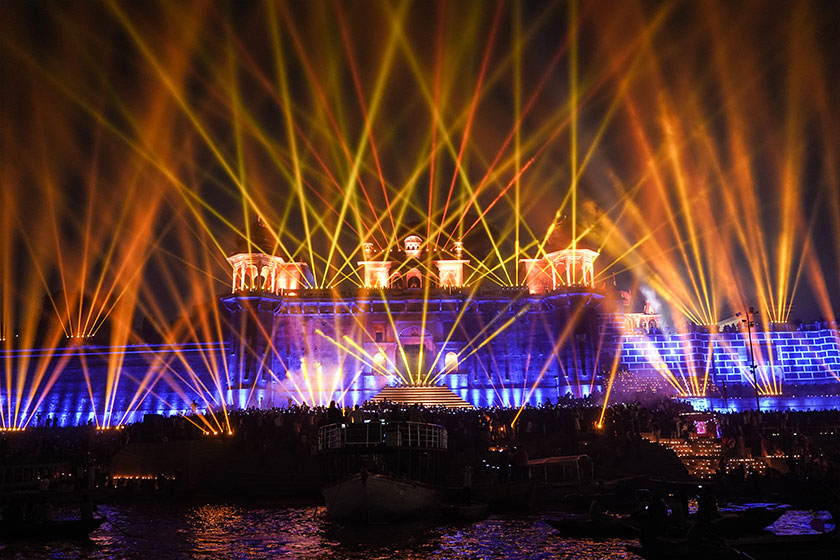Uttar Pradesh, often regarded as the spiritual heart of India, holds a vital place in the country’s cultural and religious landscape. Rich in tradition, history, and spirituality, the state is home to some of the most revered pilgrimage sites, including Varanasi, Ayodhya, Mathura, and Prayagraj. These cities are not merely geographical locations but are considered sacred centers with deep spiritual and cultural significance for millions of Hindus. They attract devotees and seekers of spirituality from all corners of the world. Among the numerous festivals celebrated across Uttar Pradesh, Dev Deepawali stands out as a divine spectacle of light and spiritual celebration. While observed in several parts of North India, its most magnificent expression is in Varanasi, the spiritual capital of India and abode of Lord Shiva. During Dev Deepawali, the ghats of Varanasi, stretching from Raj Ghat in the north to Ravidas Ghat in the south, are transformed into a shimmering carpet of light, reflecting the glow of diyas on the serene waters of the Ganges. The festival has grown into a significant tourist attraction, drawing visitors not only from across India but also from around the world who come to witness this enchanting sight and experience the spiritual essence of the city.
Dev Deepawali, meaning “The Diwali of the Gods,” is celebrated on the full moon night (Purnima) of the Hindu month of Kartik, exactly 15 days after Diwali. According to Hindu mythology, this day marks the victory of Lord Shiva over the demon Tripurasura. Hence, the festival is also known as ‘Tripurotsav’ or ‘Tripurari Purnima.’ It is believed that after Lord Shiva defeated the demon, the gods in heaven rejoiced and descended to Earth to celebrate this victory. This celestial celebration is mirrored on the ghats of Varanasi, where millions of earthen lamps, or diyas, are lit, symbolizing the triumph of good over evil and the dispelling of darkness with divine light. Apart from commemorating Lord Shiva’s victory, Dev Deepawali also marks the birth anniversary of Lord Kartik, the son of Shiva and Parvati, adding to the festival’s significance. This year, Dev Deepawali will be celebrated on November 15th, with the rituals, prayers, and offerings primarily conducted during the ‘Pradosh Muhurat.’
The festivities are marked by a vibrant array of rituals, processions, music, and dance performances along the ghats. Local artists engage the crowd with traditional folk music, bhajans (devotional songs), and classical dance, creating an atmosphere of cultural richness and joy. As the evening progresses, fireworks light up the night sky, adding to the visual grandeur. The colorful displays, set against the backdrop of the illuminated ghats, create a magical scene that symbolizes the joy of divine victory.
A significant ritual associated with Dev Deepawali is the Kartik Snan, where devotees take a dip in the holy Ganges. It is believed that bathing in the sacred waters during Kartik Purnima purifies sins and brings prosperity and well-being. This ritual draws thousands of participants who come seeking blessings and spiritual purification.
Preparations for Dev Deepawali in Varanasi are extensive, reflecting its cultural and spiritual significance. Weeks before the festival, there is a concentrated effort on cleaning and beautifying the ghats. Local authorities, volunteers, and social organizations collaborate to ensure that the ghats are spotless and well-organized for the grand event.
Varanasi, one of the oldest living cities in the world, is a place where spirituality and culture blend seamlessly. Known for its ancient temples, the city is home to several significant Hindu shrines, including the Kashi Vishwanath Temple, dedicated to Lord Shiva, the Kaal Bhairav Temple, Annapurna Devi Temple, and Sankat Mochan Hanuman Temple, among many more. Visitors coming for Dev Deepawali can also explore these revered sites, offering prayers and seeking blessings, making their experience in the city even more spiritually enriching. The festive season brings an added charm to these temples, with vibrant decorations and special rituals.
Leading up to Dev Deepawali, the Ganga Mahotsav is organized, a five-day cultural festival that celebrates the heritage of Varanasi with performances by renowned artists, craft fairs, and exhibitions. These events showcase local art, cuisine, and handicrafts, highlighting the city’s rich cultural traditions. Tourists can indulge in the flavors of Varanasi’s famous street food, from ‘kachoris’ and ‘jalebis’ to ‘banarasi paan’, as well as explore local crafts like ‘Banarasi Silk sarees, wooden toys, and brassware that reflect the city’s artisanal heritage.
Given the massive turnout of visitors, safety and crowd management are crucial. Comprehensive security measures are in place, with police, volunteers, and disaster management teams ensuring the smooth conduct of events. Boats are arranged to offer tourists a unique perspective of the illuminated ghats from the river, enhancing the festive experience.
Tourist engagement plays a significant role in the success of the festival. The tourism department promotes the event on a global scale, offering special arrangements like guided tours, boat rides, and accommodation packages. These efforts allow visitors to immerse themselves in the unique blend of spirituality and culture that defines Dev Deepawali. More than just a festival, it is a divine spectacle that encapsulates spirituality, culture, and community. It is a celebration where the earthly and the divine converge, transforming the ancient city of Varanasi into a radiant canvas of light and devotion.
For those fortunate enough to witness it, Dev Deepawali is an enchanting experience where time seems to stand still, and the presence of the divine feels tangible. This celebration not only emphasizes the spiritual aura of Uttar Pradesh but also cements its status as a global center for culture and spirituality, drawing seekers and tourists from every corner of the world to its hallowed shores.


